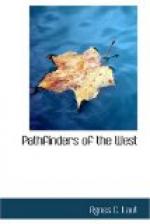[Illustration: Eskimo using Double-bladed Paddle.]
The question now was whether to wait till spring or set out in the teeth of midwinter. If Hearne left the fort in spring, he could not possibly reach the Arctic Circle till the following winter; and with the North buried under drifts of snow, he could not learn where lay the Northwest Passage. If he left the fort in winter in order to reach the Arctic in summer, he must expose his guides to the risks of cold and starvation. The Indians told of high, rocky barrens, across which no canoes could be carried. They advised snow-shoe travel. Obtaining three Chipewyans and two Crees as guides, and taking no white servants, Hearne once more set out, on February 23, 1770, for the “Far-Away-Metal River.” This time there was no cannonading. The guns were buried under snow-drifts twenty feet deep, and the snow-shoes of the travellers glided over the fort walls to the echoing cheers of soldiers and governor standing on the ramparts. The company travelled light, depending on chance game for food. All wood that could be used for fire lay hidden deep under snow. At wide intervals over the white wastes mushroom cones of snow told where a stunted tree projected the antlered branches of topmost bough through the depths of drift; but for the most part camp was made by digging through the shallowest snow with snow-shoes to the bottom of moss, which served the double purpose of fuel for the night kettle and bed for travellers. In the hollow a wigwam was erected, with the door




